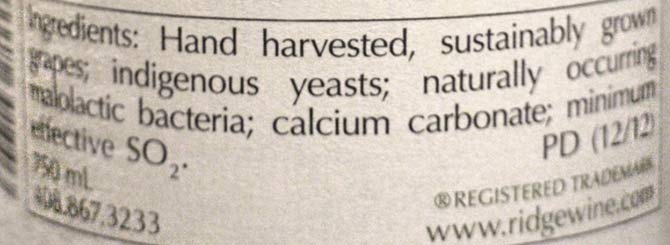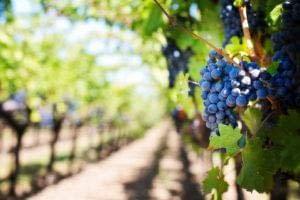The suspicious lack of nutrition labels on alcoholic beverages may leave you thinking vodka is just vodka, beer is just beer, and wine is just wine. At least that’s what I always thought! I mean, you’d think a wine would be just fermented grape juice, right?
Wrong.
The truth is, a lot of stuff can go into wines, which isn’t actually wine. Sad day. Obscure government regulations instigated by the Alcohol and Tobacco Tax and Trade Bureau (TTB) don’t help matters. According to the TTB , 60+ additives can be used in the winemaking process, including everything from acacia gum to animal proteins to folic acid. Not to mention the many pesticides, fungicides, and herbicides sprayed on the grapes in the first place.
 In fact, a “good” wine ingredient list might look like this one from Ridge vineyards, who have vowed to label their wines in testament to their minimal amount of additives. As they state, “Ridge is adding to its labels a list of actions and ingredients to demonstrate how little intervention is necessary to produce a fine, terroir-driven wine from distinctive fruit. Although an ingredient list is not required by the TTB, if a winery chooses to add a list of ingredients to its back label it must list ALL ingredients.”
In fact, a “good” wine ingredient list might look like this one from Ridge vineyards, who have vowed to label their wines in testament to their minimal amount of additives. As they state, “Ridge is adding to its labels a list of actions and ingredients to demonstrate how little intervention is necessary to produce a fine, terroir-driven wine from distinctive fruit. Although an ingredient list is not required by the TTB, if a winery chooses to add a list of ingredients to its back label it must list ALL ingredients.”
Still, I bet that picture label features a lot more ingredients than you would guess… and that’s on the low side! So when it comes to secret wine additives, let’s look at some of the biggies and funsies, shall we?
WINE ADDITIVES
SULFITES
Lack of labeling aside, wine bottles often do say one thing about their contents: “Contains sulfites.” That succinct statement actually isn’t that helpful, since all wine contains sulfites to some extent. Sulfites are highly reactive, and release sulfur dioxide to eradicate unwelcome yeast and bacteria, stabilize the wine, and prolong shelf life. The problem isn’t so much with naturally occurring sulfites (which can be quite low), but rather with added synthetic sulfites, which can reach substantially high numbers. This can yield more unbound “free sulfites” more likely to react with you.
According to the TBB, wines can contain the following amount of sulfites:
Organic Wine: < 10 naturally occurring sulfites
Biodynamic Wine: < 100 ppm added sulfites
“Made with Organic Grapes”: < 150 ppm added sulfites
All other wine: < 350 ppm added sulfites
Of course, only an estimated 1% of the population harbor an actual sulfite allergy. Headaches from wine more likely arise from histamine, tryamine, tannins, or alcohol content. Still, the potentially massive amounts of sulfites added to many wines is a bit disconcerting.
If you’re super concerned about sulfite content, you can actually add a few drops of sulfite- neutralizing compounds (which are likely just small fancy bottles of hydrogen peroxide) such as JustTheWine. Additionally, the Üllo Wine Purifier claims to remove sulfites from wine, while optionally aerating it. I shall try these and report back! (I personally like the idea of the latter, since I’m not so gung-ho on adding yet another ingredient to wine.)
sulfite- neutralizing compounds (which are likely just small fancy bottles of hydrogen peroxide) such as JustTheWine. Additionally, the Üllo Wine Purifier claims to remove sulfites from wine, while optionally aerating it. I shall try these and report back! (I personally like the idea of the latter, since I’m not so gung-ho on adding yet another ingredient to wine.)
YEAST
To make wine, yeast must ferment grapes. That’s just how it goes down. On the plus side, yeast create the whole wine thing in the first place. (Yey!) On the downside, genetically modified yeast may be finding their way into wine, such as the green-lit GMO yeast strain ML01. A genetic mutation blending yeast and bacteria, GMO yeast can aid winemakers by combining bacterial malolactic fermentation and yeast alcoholic fermentation into one step. But if you’re concerned about the health implications of GMOS (which is the subject of another post entirely), this can be problematic.
MEGA-PURPLE
Not gonna lie, I’m morbidly fascinated by “Mega Purple,” a coloring, texturizing, and potentially sweetening agent added to many (if not most) cheap and affordable wines, in order to standardize production and yield uniformity. A 68% sugared syrup concentrate made from teinturer grapes, Mega Purple lets winemakers magically color correct their wine to the lustrous liquid naturally obviously (?) intended. In other words, Mega Purple is like an Instagram filter for winemakers, except they don’t tell you you’re looking at instagammed wine. It’s a dirty little purple secret.
VELCORIN
Moving from the morbidly fascinating to the just plain morbid, we’ve got dimethyl bicarbonate, a sterilizing/stabilizing agent moonlighting by the name Velcorin. Velcorin kills potentially nasty things in wine, which I suppose is a good thing. On the flip side, the stuff is so toxic that workers must wear Hazmat suits when administering it. Yikes. While velcorin does ultimately break down into Co2 and methanol, if you did happen to drink Velcorin-laden wine within 24 hours of its addition, you just may die. No big deal.
ANIMAL BYPRODUCTS
Sorry vegans, your wine may just not be that into you. In the “Fining” process of winemaking, substances are added to wines which “glom” (stick to) unwanted particles, (like copper, proteins, and even smells and flavors) and are then removed from the wine. Fining agents can include things like: egg white, milk products, gelatin, porcine or bovine proteases, casein, and isinglass from fish bladders. (Non-animal-derived fining agents include bentonite clay and synthetic polymers.) While these substances may only reside in the final wine in trace amounts (if any), it’s still something to keep in mind.

GLUTEN
I don’t want to scare you, but wine can contain trace amount of gluten! A super sticky protein which binds to everything (like your digestive tract!), gluten can be used as a fining agent to cling to unwanted material in a wine. Gluten can also be used to seal the oak barrels used to age wine. While gluten is likely only present in very minute amounts (if any) in the finished products, for Celiacs (and those wary of gluten in general), even a tiny bit may be too much…
OTHER STUFF
In the “chaptalization” process, sugar, be it in the form of pure cane sugar or grape sugar concentrate, can be added to grape juice before fermentation to increases the ultimate amount of alcohol created by the yeast. Other compounds can be added to wine to adjust levels of acidity. For example, chalk may be added to reduce acidity, while citric, malic, and tartaric acids may be added to increase acidity.
PESTICIDES
Saving the best for last, I personally think pesticides may be the biggest problem with wine additives. Conventional grapes are typically sprayed with a number of synthetic, toxic “cides” to kill unwanted bacteria, yeast, and fungus. Pesticides can wreck havoc on our own personal gut microbiome (research suggest they may target the good bacteria in our gut), and are linked to a number of diseases. For example, the pesticide Roundup contains the compound glyphosate, which has been linked to nutritional deficiencies, increased toxicity, gastrointestinal problems, autism, and cancer. Since pesticides can become ingrained within the genetic makeup of the plants themselves, you can’t wash them off even if you wanted to!
When it comes to wine, grapes consistently rank in the Environmental Working Group’s “Dirty Dozen” – the list of produce most contaminated with pesticide residue. And it’s likely pesticide residues on grapes find their way into the final wine product. After all, to make wine, you literally let grapes soak in their skins. Umm… Studies have shown that pesticides such as myclobutanil, tetraconazole, azoxystrobin, dimethoate, and pyrimethanil are often present in wine, sometimes in amounts mirroring those found on the grapes! Scary stuff.
WINE MAKING PRACTICES

If you’re a little nervous now about all the stuff going into your nightly glass of vino, you may be interested in jumping on the non-conventional wine bandwagon, like me! But all the vague labeling, from organic to made with organic grapes to sustainable to biodynamic, can leave you scratching your head. Let’s break it all down, shall we?
ORGANIC VS. “MADE WITH ORGANIC GRAPES”
The main difference between USDA organic wines and wines “made with organic grapes,” is the amount of allowable sulfites. USDA organic wines can only contain naturally occurring sulfites, while wines made with organic grapes can have up to 150 ppm added sulfites. Here’s the more specific breakdown:
USDA Organic Wines: USDA Organic wines can only contain grapes certified organic, with no synthetic fertilizers or pesticides, grown in a way which protects the environment and soil. All added yeasts and other agriculture ingredients must be organic. Non-agriculture additives cannot exceed 5%, and must be on the “National List of Allowed and Prohibited Substances.” (Though this list features quite a bit of suspicious additives, such as agar agar, carrageenan, and non synthetic waxes. Fun times!) No added sulfites are allowed.
Wines “Made With Organic Grapes”: Wines made with organic grapes can only contain grapes certified organic (see clarification below), with no synthetic fertilizers or pesticides, grown in a way which protects the environment and soil. Added yeasts and other agriculture ingredients do not have to be organic, but they cannot be GMO. All non-agriculture additives do not have to be organic, but they must be on the “National List of Allowed and Prohibited Substances” (which, as mentioned before, is a bit scary.) A maximum of 150 ppm added sulfites is allowed.
Clarification: The whole “made with organic ___” label can be a bit vague, since only 70% of a product with this label has to contain that organic ingredient, though the entirely of that ingredient must be organic. So for example, a tomato soup “made with organic tomatoes” must contain only organic tomatoes, but could also contain non-organic broth and other vegetables. Thankfully, since wine features just grapes as the main ingredient, wine “made with organic grapes” means the wine is made entirely of organic grapes, not just some organic grapes. Yey! (If it weren’t, it would have to say “made with organic and non organic grapes,” which I personally haven seen.)
SUSTAINABLE VS. BIODYNAMIC

Sustainable and biodynamic practices speak more to the spirit of agriculture. With no central governing agent, “sustainable” is rather muddy to define, and may or may not yield organic wine. Biodynamic, on the other hand, must adhere to rigid criteria, and implies organic wine as a foundation, even if it is not labeled as such. Here are the basics!
Sustainable Wines: Sustainable wines tend to be made in a way which support the environmental ecosystem. This typically entails a focus on greener practices which don’t damage the environment, such as reduced waste byproducts and renewable energy. Third party certifiers include organizations like SCSglobal Services and Sustainability in Practices (SIP). While sustainable practices may attempt to reduce damage to human health, and may include organic wines, they do not mandate organic practices. You would need to contact individual wineries labeled as sustainable for their farming methods, especially when it comes to pesticides and additives.
Biodynamic: Perhaps the crème de la crème of agriculture practices, biodynamic methods take organic and sustainable concepts and expand into even more philosophical terrain, pun intended. The Demeter Association provides the certification standards, and includes USDA organic certification rules in their standards. Biodynamic standards are very holistic and in tune with nature, including attention to cyclical climate and earth patterns (like the lunar cycle), systems which integrate animals for natural fertilization, and encouraged biodiversity. See the full, extensive criteria here. One thing of note: biodynamic winemaking does allow added sulfites up to 100 ppm.
WHAT’S BETTER? BEST?
 Back in the day, before we even had toxic synthetic pesticides and additives to use in the first place, wine just was organic. How convenient! (I’m pretty sure the water Jesus changed into wine at that wedding didn’t contain Mega Purple and Roundup.) Such is not the case today, in a time when even wines labeled “organic” can contain nefarious, non-organic compounds. On the flipside, wines today without an organic label could be completely organic, but the wine producers didn’t take the time or, more likely, have the money to pay for the label. Indeed, many small, family-owned and especially European wineries may practice old world farming which render arguably “organic” wine. As an even crazier example, say you grow your own grapes and ferment your own wine: I doubt you’d pay to secure the “Organic” or “Biodynamic” seal, but you know where it’s coming from.
Back in the day, before we even had toxic synthetic pesticides and additives to use in the first place, wine just was organic. How convenient! (I’m pretty sure the water Jesus changed into wine at that wedding didn’t contain Mega Purple and Roundup.) Such is not the case today, in a time when even wines labeled “organic” can contain nefarious, non-organic compounds. On the flipside, wines today without an organic label could be completely organic, but the wine producers didn’t take the time or, more likely, have the money to pay for the label. Indeed, many small, family-owned and especially European wineries may practice old world farming which render arguably “organic” wine. As an even crazier example, say you grow your own grapes and ferment your own wine: I doubt you’d pay to secure the “Organic” or “Biodynamic” seal, but you know where it’s coming from.
So when it comes to wine labels, perhaps the spirit of everything is best.
It’s quite plausible that an occasional wine labeled “sustainable” may be just as good as, or perhaps even better, than another labeled “organic,” since it involves a return to the natural order of things, rather than just potentially appealing to commercialized organic zeitgeist. In fact, some even argue that the headache required to acquire “organic” labels has actually discouraged farmers from attempting such practices. {Sigh} Others argue “organic” pesticides are just as damaging as synthetic. Not to mention the aforementioned issue of many non-organic things allowed in organic wines, which can be misleading for the consumer. Of course, the spirit of organic is grand, I just fear intentions can be sacrificed and corners cut in the appealing lure of a green dollar.
So what’s a wine lover to do?
I advocate doing your research. Rather than just jumping on the organic seal bandwagon, take a moment to research the spirit and mission of the winery: are they actively making efforts to reduce harm to humans and the environment? You just might be better off at times with a wine from a small, family-owned winery, than an “organic” wine produced by a major wine conglomerate. (By the way, a mere 6 major companies are behind 60% of the wine made in the US: E&J Gallo, The Wine Group, Constellation Wines, Bronco, Trinchero Family Estates and Treasury.)
That all said, I still think organic wines are a great step in the right direction, and I’ve been trying out a ton of them recently myself. And if the big powers that be want to jump on the organic bandwagon, I say more power to them. When I go to restaurants myself, I try to stick to wines labeled organic, sustainable, or biodynamic if available. And speaking of that last one, biodynamic may indeed be the best way to go.
References
http://www.ncbi.nlm.nih.gov/pmc/articles/PMC3476173/
http://onlinelibrary.wiley.com/doi/10.1111/head.12365/full
http://www.marketwatch.com/story/organic-foods-and-beverages-global-markets-2014-06-19
http://www.hindawi.com/journals/bmri/2014/179691/
http://www.winespectator.com/webfeature/show/id/46432
https://www.ttb.gov/pdf/wine-labeling-guide.pdf
https://www.ttb.gov/wine/wine_treating_materials.shtml
http://www.winesandvines.com/template.cfm?section=features&content=51033
http://onlinelibrary.wiley.com/doi/10.1111/head.12365/full (wines and headache)
http://articles.mercola.com/sites/articles/archive/2013/06/09/monsanto-roundup-herbicide.aspx
http://www.mdpi.com/1099-4300/15/4/1416
http://www.reuters.com/article/roundup-health-study-idUSL2N0DC22F20130425
https://www.ams.usda.gov/rules-regulations/organic/national-list
http://www.ecfr.gov/cgi-bin/text-idx?c=ecfr&SID=9874504b6f1025eb0e6b67cadf9d3b40&rgn=div6&view=text&node=7:3.1.1.9.32.7&idno=7
http://napavalleyregister.com/news/local/workers-treated-after-being-exposed-to-pesticides-while-trimming-sprayed/article_55917cd6-a755-11e0-8ca2-001cc4c002e0.html
http://www.decanter.com/wine-news/bordeaux-school-children-sick-from-vineyard-pesticides-say-officials-12745/
http://vinepair.com/wine-blog/heres-why-your-organic-wine-is-actually-really-bad-for-the-environment/
http://www.sustainablefoodpolicy.org/third-party-certifications-for-identifying-sustainably-produced-foods
http://theorganicwinecompany.com/biodynamic-wine/


